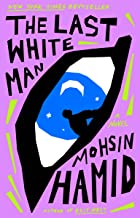The Last White Man by Mohsin Hamid
The central theme of Mohsin Hamid’s The Last White Man (Riverhead Books) is straightforward: race is a construct. In this highly anticipated novel from the author of the bestselling Exit West, the main character Anders is distressed when his skin suddenly changes to a deep, unmistakable shade of brown. He finds the challenge of adapting to life as a person of color daunting; each interaction with friends, family and even strangers, is radically different from his experience as a white person. The Last White Man illustrates the absurdity of discrimination based on the color of a person’s skin and the frightening inequality that arises as a result.
EXPLORATION OF RACE AND PRIVILEGE
The Last White Man is a compact, powerful allegory, focused primarily on racism but also touches on themes of family dynamics, change and transition in a broad sense, and even death. Anders wakes one morning, looks in the mirror, but does not recognize the face that stares back at him. His skin has suddenly changed from white to brown and that change alone is enough to make him question if he is even the same person he was before.
Leaving his apartment, he notices that people are reluctant to make eye contact, some even cross to the opposite side of the street as he approaches. A recent acquaintance, Oona, meets Anders for a date; caught off guard by his transformation, she stops responding to his messages and initially won’t return his calls. The most candid reaction to Anders’ darker skin comes from the owner of the gym where he works: “I would have killed myself.”
THE BEST AND WORST OF HUMANITY
As Anders tries to overcome feelings of isolation and disembodiment, more and more people in the city experience the same transformation. Panic and confusion grip the city; resistance to the “intruding” brown faces becomes increasingly violent. Groups of armed white men patrol the streets — unchecked by police — causing harm to anyone who crosses their path.
Oona, a minor character in the opening chapters of the book, comes to play a more central role. She gives Anders another chance despite the color of his skin, and they begin a relationship to the horror of her outspoken mother. As dark skin becomes nearly ubiquitous, Oona wonders why she hasn’t yet experienced the change. When her moment arrives, she has the unique attitude of welcoming the transition and revels in the very subtle but noticeable changes that she experiences. Oona experiences joy, not in the new color of her skin, but in the transition itself — a chance to begin a new chapter of her life.
HAMID WRITES WHAT HE KNOWS
Author Mohsin Hamid has approached racial politics in each of his previous novels, writing on the theme with insight and appealing to the humanity of the reader. A native of Pakistan, educated at Princeton and Harvard and living for a time in the UK, Hamid insists that seeing people in terms of black, brown, or white creates an oversimplified binary for the immense complexity within the human race. In place of the trademark realism of his previous books, The Last White Man is decidedly allegorical.
Hamid employs language and tone thoughtfully in this novel. Concise chapters punctuated with powerful sentences increase the impact of these pages. Specific details of setting and character development are limited, with the focus primarily on thoughts, attitudes and actions.
The story is told in lengthy, flowing sentences — sometimes extending for an entire page — generating a sense of augmented imagination and suspended reality. The author executes complex manipulations of grammar and sentence structure without making the novel difficult to read; it is, in fact, a book that many readers may devour in a single sitting.
STUNNING WORK OF SPECULATIVE FICTION
The Last White Man is a meaningful addition to contemporary discourse on racism. This is a must-read for those who enjoy the work of Toni Morrison, James Baldwin, and other writers focused on mapping social divides.
Hamid presents a powerful denouncement of prejudice, illustrating the horrible consequences of racial constructs. A pointed central theme, clear message and purposeful allegory make this a memorable read. Readers interested in matters of social justice, equality and speculative fiction will enjoy The Last White Man.
Read what Jennifer Blankfein thought of The Last White Man by Mohsin Hamid on Book Nation by Jen.
About Mohsin Hamid:
Mohsin Hamid is the author of five novels — The Last White Man, Exit West, How to Get Filthy Rich in Rising Asia, The Reluctant Fundamentalist and Moth Smoke — and a book of essays, Discontent and Its Civilizations.
His writing has been translated into forty languages, featured on bestseller lists and adapted for the cinema.
Born in Lahore, he has spent about half his life there and much of the rest in London, New York, and California.





